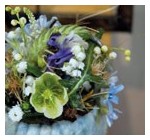The airplane
- Out-of-Stock
Home delivery everywhere in Switzerland from Monday to Saturday! Also find our bouquet distributor 7 days a week.

The month of May means spring. And with the return of fine weather, it is also soon back, the lovely time of the lily of the valley! Queen of the undergrowth, it is one of the first perennials to bloom in the plain at this time. The lily of the valley, a pretty bell-shaped flower, looks like a little fairy, so fragrant and yet terribly deadly...
From time immemorial, the 1st of May has given rise to spring festivities. Ancestral rites already celebrated the return of spring and the approach of summer on this day.
The Celts celebrated its arrival by lighting fires on the "night of Beltaine", on 30 April. Beltaine (the name of the month of May in Irish, "Mí na Bealtaine") marks a threshold in the year, when the clear season is well underway. It is also a change of life, as it is the beginning of daytime activities: hunting, warfare and conquests for warriors, and the beginning of agricultural and field work for farmers and herders. Beltaine is the preferred period for rites of passage between the cold and warm periods, between darkness and light, between psychic death, or symbolic torpor, and spiritual rebirth.
In general, Beltaine is the festival of the change of rhythm of life. From the winter rhythm, we pass to the summer rhythm. The festival marks this transition both physically and spiritually.
The ancient accounts emphasise the fires lit by the druids, who pronounced magical incantations as the cattle were passed between the fires, in order to protect them from epidemics for the whole year. The 'Fire of Bel' is a beneficial cleansing fire brought about by effective incantations. The Fire of Beltaine is powerful, sacred and strong, the one who lights it must be a person of power. Beltaine is the exaltation of fire, the element of worship par excellence.
The Germans and Scandinavians used to light it to purify the air and drive out witches. In ancient Helvetia, it was welcomed with songs and by giving sweets to children.
This custom has French origins. In France as elsewhere, the month of May was traditionally dedicated to love. It was celebrated in different ways. Traditionally, on the first of May, people wore a wreath of lily of the valley leaves and flowers and offered them to their loved ones. It was also customary to leave small bunches of lily of the valley sprigs in front of the house of the desired girl at night. This is probably why the verb "mugueter" meant "to be gallant" with the ladies. The lily of the valley is also found in the buttonholes of young people who come to the "lily of the valley ball" organised on May 1st. It is said that this was the only ball where parents were not allowed. Young people could thus show their mutual interest.
Around 1900, the lily of the valley made its entry into Parisian haute couture. Clients, saleswomen, seamstresses and small hands received a sprig of lily of the valley offered by the great couturiers who thus established a new fashion. Christian Dior even made it the emblem of his fashion house.
Nowadays, the lily of the valley is a symbol of renewal, friendship and good luck, and the sprig of lily of the valley is offered as a good luck charm, or just to please. In the language of flowers, the lily of the valley symbolises the ardour of youth, coquetry and the return of happiness. At Bouvard fleurs, we offer it for sale both as cut flowers and in pots. We also make many small, fragrant bouquets for gifts, combining sweet peas and lily of the valley. We also work this pretty spring flower into small quilted arrangements that we have delivered throughout the canton of Geneva.
Convallaria majalis, as it is known, is native to Japan, where many of its cousins also thrive in cool, shady wooded areas. It is a highly toxic, even lethal plant. In temperate European forests, where it occurs naturally, lily of the valley is (along with periwinkle) a good bioindicator of the age and naturalness of the forest. The plant is often used as an ornamental plant but it only flowers for a short time (3 to 4 weeks).
The plant is easily grown in the garden, as long as the garden is cool and shaded, without direct sunlight. Although quite invasive due to its rhizomes, it is a pretty ornamental plant that is easy to maintain. However, it is advisable to remove spent flowers before they set fruit, especially when children are likely to have access to the garden. Lily of the valley berries, whether ripe or not, look like little candies and are very attractive but very poisonous.
The largest producers of lily of the valley are in the Nantes region of France. Lily of the valley is often known as "Nantes lily of the valley". In French-speaking Switzerland, some growers cultivate it for cut flowers or as a pot plant.
As mentioned above, lily of the valley is unfortunately a very poisonous plant. Underneath its charming appearance, lily of the valley is a tonic and diuretic. In any use, it is very important to remember that all parts of the plant are highly toxic. Lily of the valley is classified as a very highly toxic plant, an ingestion of a sip of lily of the valley water can be fatal within minutes. The plant contains saponosides (which cause irritation) and about twenty cardiotoxic heterosides (dangerous for the heart): convallatoxin, convallatoxol, convaloside...
Ingestion causes digestive problems consisting of irritation of the mouth, abdominal pain, nausea, vomiting and diarrhoea. This is followed by heart rhythm disturbances with accelerated breathing. Death is caused by cardiac arrest.
In case of ingestion, call the nearest poison control centre as soon as possible. It is therefore advisable to exercise a minimum of caution when offering it, especially if there are children and animals around.
It is the main enemy of novice woodland collectors, who often mistake its leaves for those of wild garlic. In order not to be fooled, 3 details should be kept in mind. The characteristic smell of bear garlic and the absence of veins on the leaf of the latter. The tougher Lily of the Valley leaf grows almost flush with the ground in an interlocking fashion.
Like many other poisonous plants, lily of the valley has - in appropriate doses - pharmacological properties, and has been used in the treatment of particular heart diseases. Its domestic use is however to be proscribed because of its lack of interest and especially because of the mortal danger that it would run.
It is especially in perfumery that the lily of the valley gains its letters of nobility and is especially known, even if it is not used in its natural form. As early as the 16th century, lily of the valley was a popular perfume, especially for men, since the term "lily of the valley" was used until the 19th century to describe an elegant young man. Today it is used in women's perfumes as a heart note. Various synthetic ingredients, such as hydroxycitronellal, lilial, terpineol, etc., allow the perfumer to recreate the scent of lily of the valley.
The lily of the valley, in soliflore, made the fame of the perfume Diorissimo, created in 1956 by Edmond Roudnitska. In addition, the lily of the valley note is often used as a functional fragrance, to scent cleaning products.
1 May is also Labour Day.
This date pays tribute to the trade unionists and workers who were murdered or imprisoned during the general strike launched on 1 May 1886 by the workers' movement in the United States of America to win the 8-hour working day. They chose to start their action on May 1st, which for many American companies was the beginning of the new accounting year.
So on May 1, 1886, more than 340,000 workers decided to take action by leaving their workplaces in the factory to demonstrate their demands in the streets. Some of them got satisfaction, but not most of them. The strikes continued. At the time, these conflicts between workers and employers were considered to be real revolts and a threat to public order.
In Switzerland, May Day was only celebrated in certain cantons (Basel, Jura, Neuchâtel, Schaffhausen, Solothurn, Ticino, Thurgau, Zurich) or districts. The trade unions organise marches in the afternoon or at the end of the day in the cantons where this day is not a holiday.
If you don't have the time to come and admire all our beautiful confections in the shop, our web shop for deliveries throughout Switzerland is also transformed to celebrate spring. Our online shop is full of gift ideas to celebrate the 1st of May in the right way.
Click, choose your bouquet size, delivery area and recipient, and we'll take care of the rest! From warm or pastel shades, round or slender bouquets, dried flower bouquets, spring mixes, or a bouquet of 100% Genevan tulips, find the perfect present to send throughout Switzerland. Each of our bouquets is made with fresh flowers of the day, always paying attention to their quality.
Easy, fast, high quality and at attractive prices: It has never been easier to send flowers.
You can also choose to accompany your bouquet with a good bottle of Genevan wine, or why not, a delicious box of chocolate eggs, made in the canton with passion and know-how.
If you are unable to visit our shop on the day, we have two flower dispensers available for you to use 24/7 (in Perly-Certoux and Carouge). During this busy period, our teams of employees take turns to ensure that the dispensers are always filled with our most beautiful creations.
Accessible every day and at all hours of the day, composed of mixed flowers, roses, seasonal and regional flowers, our bouquets are stored in a controlled environment, in order to guarantee you freshness and durability. We constantly renew our floral arrangements. The water is replaced at regular intervals and the flowers are changed every day. Our bouquets are accessible to all budgets. ( from 20.- to 40.- CHF).


© 2022 - BOUVARD FLEURS. ALL RIGHTS RESERVED.





![]()